Published on 29
Aug 2018
|
All rights reserved.
|
|
Corolla Hatchback / Sport
|
|

|
|
Auris
is gone. Corolla hatchback is in. However, is this really a Corolla?
|
|
When
I drafted this page yesterday. It was named Toyota Auris Mk3. Somehow,
in the evening of the very same day, Toyota Europe suddenly announced
that it had changed the car’s name to Corolla, even though the Auris
name was already announced back in Geneva motor show this March. In
this way, its name is unified across the globe. In Japan and North
America, it is called Corolla Sport and Corolla Hatchback,
respectively.
In my opinion, Auris is the better name, because it makes clear that
the car is
not a Corolla. What is a Corolla then? In Japan, you get this Corolla. In USA, another Corolla. They are already so
different, but what they are in common is a 3-box sedan form. Unlike
them, the Auris was a hatchback designed specially to the taste of
Europe. It started in 2007 and was renewed in 2012. Production took
place in UK. So what drives Toyota to abandon the nameplate? Maybe
sales result was not great, it needs to sell more cars in Japan and
America, where the Corolla nameplate is more popular. Another possible
reason: to reinforce the Corolla’s lead as the world’s best-selling
car. If that's not enough, maybe Toyota could rename Prius and RAV4 to
Corolla, too. How nonsense the game is!
As before, the successor of Auris is assembled in both Japan and UK.
Needless to
say, it is built on the “everything platform”, TNGA. However, TNGA is
meaningless. To give you a clearer picture, you can see it as the
sister car of C-HR crossover, with which it shares the underpinnings.
Compared with the last Auris, it is
slightly larger – 40mm longer, 30mm wider and 40mm longer in wheelbase,
although its roof is lowered by 25mm to enable a sportier look.
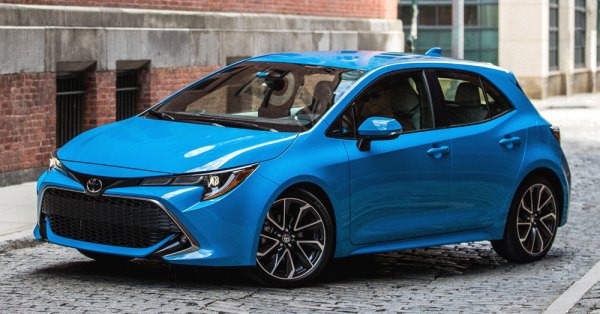
|
|
It
looks sharp and stylish under the right light reflection.
|
|
And what a look! It is really a major improvement. While the old Auris
looked like an MPV, the new car has a much sportier form.
Its angular nose sports an oversized grille and wing-shape headlights.
The side has a sweeping waistline and crisped crease lines that work
well under light reflection. The tail looks like a Mazda 3 hatchback.
On
the downside, you might say the front end design OTT, considering how
little air its small engines demand. The way the clamshell bonnet meets
the nose look a bit strange. Besides, when sunlight come from
the wrong direction, the crease lines become invisible and the car
could look a bit soft and fat. Still, it is a far more interesting
design
than the old Auris, or any members of the current Corolla family (which
is not a difficult task, admittedly).
The cabin is also unusually stylish and well finished for a cooking
Toyota. The sweeping dashboard looks like furniture.
It is made of soft-touch plastic, or even trimmed with leather
upholstery on top-spec model. So is the steering wheel. The 8-inch
touchscreen stands proudly on a piano-black console. It is supplemented
with hardware knobs. The door handles and armrests are padded. Hard
plastics exist only at the lower level where you rarely touch. However,
although the infotainment screen displays crisped graphics, its
software is not quite as intuitive as rivals, and its response is slow.
The cabin also suffers from the side effect of a stylish exterior: more
cramped than the class norm. Passengers up to 6 feet can slip
into the rear seat only if the front occupants are willing to
cooperate. Shoulder room is compromised by the tapered body shell.
Front space is okay, though you are always aware of the fast-angle
windscreen. Visibility to the rear quarter is hampered by the thick
C-pillar and high waistline.
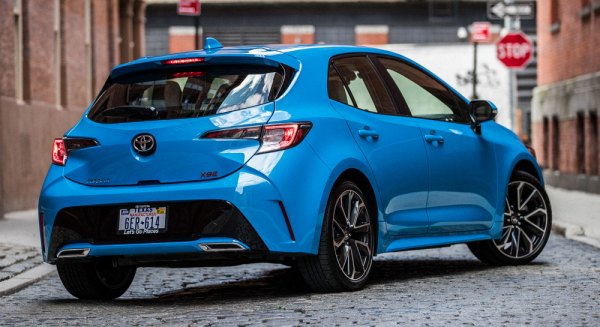
|
|
The
cabin is unusually stylish and well finished for a bread-and-butter
Toyota.
|
|
At the back, the boot is not only small by class standard, but access
is made difficult by a high load lip and load bay floor – the latter
makes space for the battery pack of hybrid models. Unexpectedly, this
Corolla
sacrifices practicality for style.
To serve the needs of different markets, the car offers 4 engine
options: 116hp 1.2-liter Turbo (from C-HR), 122hp 1.8-liter
Atkinson-cycle electric hybrid (from Prius), 168hp Dynamic Force
2.0-liter direct-injection (new development, for America only) and
lastly the hybrid version of the 2.0-liter with 180hp (for Europe
only). It goes without saying the hybrid powertrains are served
exclusively with the dronely planetary CVT, while petrol engines can be
paired with either a slick-shifting 6-speed manual or a new CVT, which
uses a fixed start-up gear to largely eliminate rubberband effect.
The least powerful 1.2 turbo is a decent workhorse, running smoothly
and quietly if not quickly. Relatively speaking, the naturally
aspirated 2.0 is the choice for keen drivers. It should be good for
0-60 in 8 seconds or less when paired with manual gearbox. A hot hatch
it ain’t, at least it brings some fun passing slower cars on motorway.
But
ultimately, it is not an engine you would feel excited, because it
lacks the
punchy mid-range of its turbocharged rivals (now nearly all others
employ turbo), and its exhaust note sounds coarse at the top end. The
only thing it beats others is fuel economy. Although the two hybrid
powertrains are not available to test yet, we don’t have high
expectation. The Prius unit has been proven and its quality is
well known – very frugal but slow and noisy. Moreover, its extra weight
over the nose of the car downgrades handling, as you can find on the
C-HR with which it shares underpinnings.
 |
|
If
you want it to be niche, you won't call it Corolla.
|
|
The manual gearbox shifts well but the clutch is light and vague,
difficult to judge the transition point. The new CVT is far more
refined than conventional thanks to using the fixed gearing for jobs
from start-up to 25 mph, then the steel belt takes over seamlessly.
When
left to its own devices, it works smoothly. Switch to manual mode and
use its 10 artificially simulated ratios to speed up response, however,
it is
obvious that a CVT is no replacement to twin-clutch, as its gearshift
is unresponsive yet jerky.
While other Corollas ride on torsion-beam axle at the back, the Corolla
hatchback follows the tradition of Auris to employ independent rear
suspension, now calls multi-link setup instead of the previous,
slightly misleading double-wishbones. There are still no adaptive
dampers, but improvement to ride and handling is made possible by the
new chassis, which is a massive 60 percent stiffer torsionally than the
outgoing model, and its center of gravity is lowered by 20mm. The ride
is supple and quiet on 16-inch wheels. Moving to 18-inch wheels and low
profile tires, it does not ride as smoothy and quietly as VW Golf,
Jetta or Chevrolet Cruze, but it is not harsh either. Handling is a
similar story, the Corolla hatchback attacks corners with a reassuring
feel. It grips well. It steers precisely, if the helm is a bit light
and numb. Body roll is well contained. Mid-corner bumps rarely unsettle
its balance. It doesn’t interact with the driver as much as a
Mazda 3, Ford Focus or Honda Civic, but it is not a boring machine as
it used to be.
That said, it must be noted that the car does not feel outstanding in
any particular area. Is it a driver's car? No, not until its chassis
gets sharper response and a better engine. Is it the choice for
comfort-seekers? No, it just lacks the cabin and cargo space to do so.
Does it feel niche in the class? Well, Toyota sold 44 million Corollas
in the past 50 years. If you want it to be niche, you won't call it
Corolla.
|
Verdict:    |
Published on 3
Mar 2020
|
All rights reserved.
|
|
Corolla Sedan
|
|
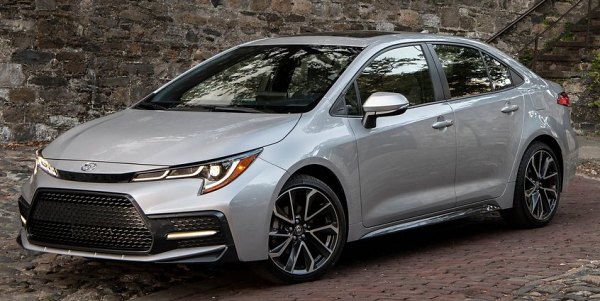
|
|
New
Corolla sedan turns to a more aggressive styling and a new independent
rear suspension.
|
|
The
last 8 years has been confusing in the history of Toyota Corolla. While
its sales number accumulated to more than 46 million units, we were not
sure what the nameplate actually meant – is it a B-segment sedan
serving Japan under the name Corolla Axio? or the larger C-segment
sedan available to the rest of the world? The fact that Toyota put 2
completely different cars under the same name casted doubts over its
sales success and all the claims of world records. Anyway, with the
launch of the 12th generation Corolla sedan, the controversy is finally
over. Now the Corollas of all markets, no matter which body styles,
share the same styling and ingredients. They still differ in size, but
the difference is more like SWB versus LWB models. Predictably, the
Japanese market Corolla is smaller, just to fit the smaller road and
parking space of the country. It measures 4495 mm in length and 2640 mm
in wheelbase, the latter is shared with the hatchback version launched
a year ago. Meanwhile, the overseas version is 4630 mm long and runs a
2700 mm wheelbase, the latter is unchanged from the last generation
international version. It is slightly wider as well, although the extra
width is spent to shoulders and fenders rather than cabin space. Both
share the same sleek, one-box silhouette, the same head and
tail-lights. The nose and grille are styled differently to suit the
customer taste of different markets, but overall the differences are
insignificant. Comparatively, the hatchback’s styling is sportier and
more attractive than the sedan.
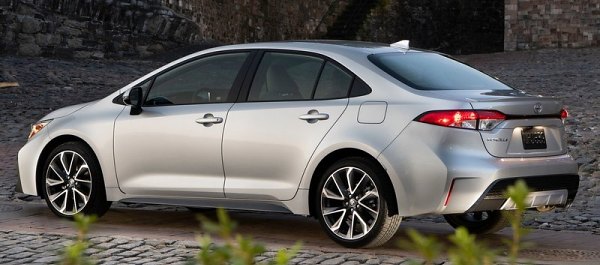
|
|
Engine
range remains a weakness.
|
|
From styling point of view, the new Corolla sedan is definitely a big
improvement, although few would buy it for styling. You would buy it
for reliability, affordability and fuel economy. Unquestionably, the
new Corolla continues to be a highly practical car, but it also gets
more rounded this time around. The exterior styling is a sign that
nowadays Toyota understands the importance of emotion. The interior
sees it putting perceived quality on higher order. The dashboard looks
cleaner and more stylish. The high-mounted touchscreen looks more
sophisticated. The materials are more decent, even though it loses some
soft-touch plastics of the European hatchback. Compared with the last
generation, the new car is lower, no matter seating, cowl or waistline,
so it affords better outward visibility. The rear seat is still good
size for adults, although it does lose some legroom due to a new
suspension.
Yes, the Corolla has finally abandoned low-cost torsion-beam axle for a
multi-link setup, and it is standard across the board. In addition to a
chassis that is 60 percent torsionally stiffer than that of the old
car, no wonder the new Corolla behaves more matured on the road. The
ride is more composed and less unsettled by bumps, if not exactly
supple. Cornering is more stable. Noise is better controlled.
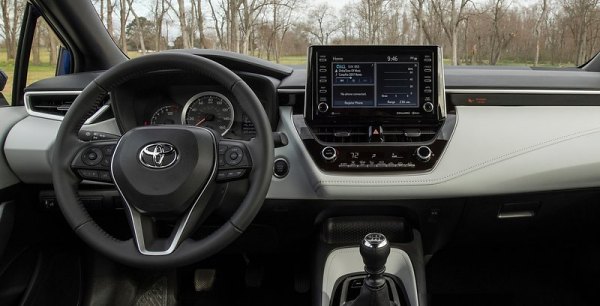
|
|
Interior
is vastly more stylish. |
|
Nevertheless, it is still far from being a driver’s car, unlike a
Civic, a Mazda 3, a Focus or even a Golf. The electric power steering
with column-mounted motor is too light and lack of feel. Roadholding
from its tires, even with the biggest 225/40R18s, is mediocre. The
sharper turn-in and tighter body control of its rivals are missing
here. This means the Corolla is still very much a household appliance –
more effective than emotional.
Neither is it quick. With the exception of the least powerful (116 hp)
1.2-liter turbo, Toyota still resists to offer proper turbocharged
engines to its best seller. Like the hatchback, the fastest Corolla
sedan is powered by a 2-liter four with 168 hp and a modest torque of
151 lbft. Even when mated with 6-speed manual gearbox, it takes more
than 8 seconds to go from 0-60, thus is the slowest among its rivals.
Further down, you’ll find either the aging 1.8-liter VVT-i engine (139
hp) or the 1.8-liter Atkinson-cycle hybrid powertrain donated by Prius
(122 hp combined). The former is slow, while the latter is painfully
slow. The hybrid model is remarkably frugal, but otherwise it has no
much to praise for. Ditto the CVT box used on both the 1.8 and 2.0
engines. The 6-speed manual on range-topper is more eager, but still no
match for a Honda box.
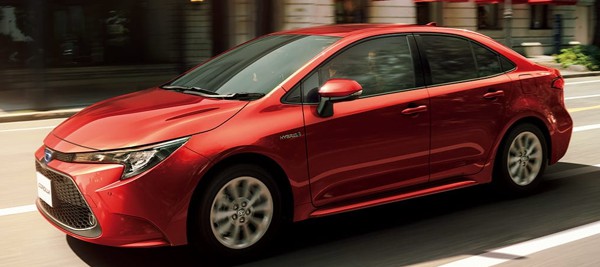
|
|
Japanese
market Corolla is shorter and narrower.
|
|
Overall speaking, the Corolla sedan is still a big improvement from the
old car. It is more stylish, completed with a more attractive interior,
and its stiffer chassis and more sophisticated suspension combined to
offer a better ride and handling. However, given a baseline so low,
such a vast improvement is not something worth applauding. Compared
with its competitors, the Corolla is still too slow and too short of
driver appeal. It is not even one of the most comfortable or refined.
What it does achieve is an unoffending package, with no special areas
of strength as well as weakness. A desirable car it is still not, but
should keep selling in big numbers.
|
Verdict:    |
Published on 20
Oct 2022
|
All rights reserved.
|
|
GR Corolla
|
|

|
|
Toyoda
wants to repeat the magic of GR Yaris on a larger hot hatch, and it
mostly succeeds.
|
|
GR
Yaris was one of the biggest surprises in
recent years. It took Toyota’s hot hatch offerings from zero to hero,
thanks to the expertise gained in its WRC program and the determination
of Akio Toyoda to crack the affordable driver’s car market. Following
the success of that car, Toyoda wants to repeat the magic on the larger
Corolla hatchback. Here comes the GR Corolla.
Although it is not designed for motorsport homologation, the GR Corolla
is no less serious than its smaller brother. It shares the same
enthusiastic heart, just differs by focusing on track performance
rather than mountain roads. Being a larger car, this is probably wise.
The GR Corolla is obviously developed from the mass production Corolla
Hatchback, but it offers 3 levels of modifications to suit your needs,
depending on how serious you want to go on track days.
The standard car is called Core. Its exterior is already far hotter
than the lesser Corollas: a massive front grille feeds its large
intercooler, accompanied with pronounced front splitter, side skirts
and widened fenders front and rear. The latter accommodate 235/40R18
Michelin Pilot Sport 4S tires and tracks that are 60mm and 85mm wider
front and rear. At the back, the diffuser might be pseudo, but the 3
exhaust pipes are real. A small spoiler is added to the top of the
tailgate to reduce lift.
The GR keeps the Corolla’s 5-door body shell, unlike its smaller
brother which uses a bespoke 3-door shell, but still its chassis is
reinforced with extra spot welds, structural adhesives, underfloor
bracings and rear tower bar. Aluminum bonnet and front doors cut
weight. The brake package comes straight from GR Yaris, with 356mm
discs and 4-pot calipers up front. However, carrying 200 kg extra
weight its braking performance is not as remarkable as GR Yaris.
Power comes from the same 1.6-liter 3-cylinder turbo motor as GR Yaris,
but with low-back pressure exhaust and remapped ECU to enable 1.74 bar
of maximum boost pressure, horsepower is lifted from 272 to 304 hp at
6500 rpm (both JIS figures on Japanese spec cars; European GR Yaris has
only 261 hp DIN). Maximum torque stays at 273 lbft, produced between
3000-5500 rpm. It’s not terribly torquey low down, so you need to work
on the mandatory 6-speed manual gearbox to get the best of it, which is
fun. After all, this is the world’s most powerful production 3-cylinder
engine as well as 1.6-liter class engine.
Power is transmitted to the same GT-Four all-wheel-drive system like
its smaller brother. The latter uses a multiplate clutch to control
front and rear torque split, allowing the driver to choose among 50:50,
60:40 or 30:70. On the Core model, the front and rear differentials are
open.

|
|
The
only weakness is the 3-cylinder motor, simply too small to win over its
larger rivals.
|
|
That’s why track days drivers had better to consider upgrading to
Circuit pack. This adds not only a Torsen LSD to each axle but also a
sheet-molding carbon-fiber roof panel to cut weight and lower center of
gravity. A larger rear spoiler adds downforce.
On the top of the tree is Morizo edition. It takes some explanation of
the name. In 2007, Akio Toyoda was already the vice president of
Toyota. To sharpen his own driving skill and train his engineers, he
formed Gazoo Racing and participated in Nurburgring 24 hours race.
However, afraid of drawing criticisms from investors or the public for
taking risks or placing personal hobbies above company interests, he
used the fake name Morizo Kinoshita to register the race. Since then,
Morizo became his nickname in motorsport.
Named after the nickname of big boss, Morizo edition of GR Corolla gets
the following upgrade on the basis of Circuit pack:
- Maximum torque is boosted to 295 lbft at 3250-4600
rpm, thanks to using 1.81 bar boost pressure.
- The first 3 ratios of gearbox get closer for stronger
acceleration.
- The body shell is reinforced further with an
additional brace at the rear and more structural adhesives.
- The rear seat has been ditched, ditto the rear wiper,
the power mechanism of rear windows and rear door speakers. In addition
to using lighter forged alloy wheels, kerb weight drops to 1445kg, 30kg
less than Core model or 47kg lighter than Circuit pack.
- Tires are upgraded to Michelin Cup 2 and get 10mm
wider.
- The all-black interior gets special bucket seats and
a suede-trimmed steering wheel.
The Morizo edition is limited to only 200 units and bounded in the US
market. It is sold for $51,000, versus $37,000 of Core model and
$44,000 of Circuit pack, thus bridges the gap between Civic Type R /
Golf R and A45 / RS3.
On the Road
At the moment, no one outside Toyota knows how the GR Corolla drives on
the road, because only motoring journalists were invited to drive it on
track. However, for a car with such track focus, at least for Circuit
pack and Morizo, assessing its performance on track is not inadequate.
There, the GR Corolla is fabulous to drive.
Keen drivers will be satisfied with its spot-on driving position,
enveloping seats, a firm brake pedal, a light and easily modulated
clutch, snappy gearchange (plus rev-matching) and a steering that is
quick and accurate, if a little short on feel. The car turns in
eagerly, just as a good hot hatch should. The body leans a little in
corner but doesn’t hurt confidence. Traction and grip offered by the
4WD system is outstanding. At 50:50 mode, the car corners with close to
neutral balance, with just a hint of understeer at the limit. This is
also the setup to achieve the fastest lap time. 30:70 will shift the
balance rearward, allowing a freer rear axle. You can use sudden
lift-off and counter-lock to move the tail out by a few degrees, but
the oversteer is pretty subtle, never going to bite you. For sure the
smaller and lighter GR Yaris is more agile and more fun to drive still,
but the GR Corolla is a more stable hence faster machine on track.
That said, performance measurement seems to be just average in the
crowd of modern hot hatches. The engine, despite its top-tier output
figures, is still a 1.6-liter. Before it really wakes up at around 3000
rpm, it feels nothing special, except the especially heavy turbo lag.
You need to keep it boiling between 3000 and 6500 rpm to deliver the
best. When pushed, the exhaust flap opens the third pipe for a more
exciting noise. Even so, it is still too subdued for a hot hatch,
especially at lower revs. Early test figures from Motor Trend found the
GR Corolla took 5.4 seconds to sprint from rest to 60 mph, considerably
slower than the sub-5 seconds claim. Other performance figures like
quarter mile, skidpad g-force and braking distance are equally
disappointing, trailing the likes of Type R, Golf R and Hyundai N.
Opting for Morizo might narrow the gap. Its extra mid-range torque and
closer ratio gearbox sharpen response a lot and makes you easier to
keep its engine running within its power band. The Morizo’s stiffer
suspension tightens body control significantly in corner. Its beefy Cup
2 tires produce outstanding grip. The result is a sharper and more
serious track machine. Lift-off oversteer and four-wheel drift are
still possible, just happens at higher speed and takes stronger effort.
Outside a track, the other versions might be easier to enjoy because of
their lower limits.
While road behaviour remains unknown, it doesn’t seem to ride as hard
as a Megane RS Trophy. The relatively quiet engine should serve
cruising duty well. What the GR Corolla fails to match the
class-leading Type R or Golf R is largely down to its smaller engine.
|
Verdict:     |
|